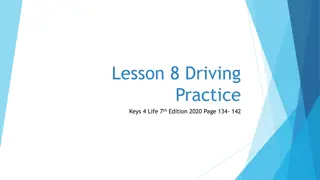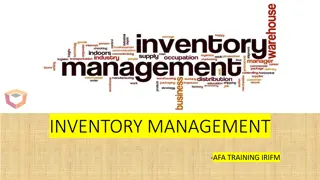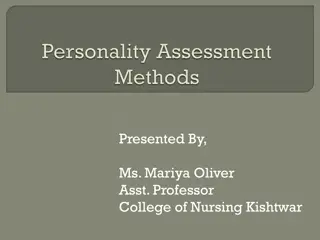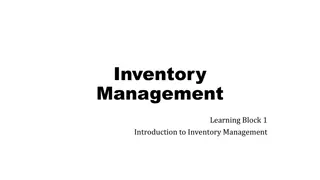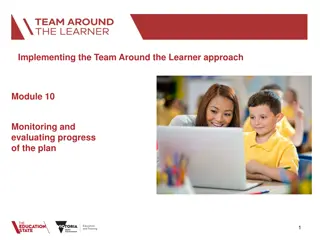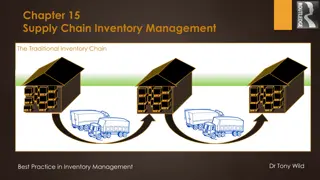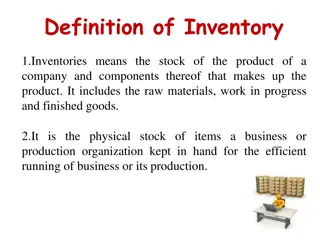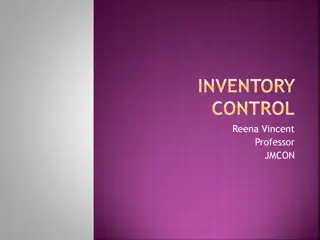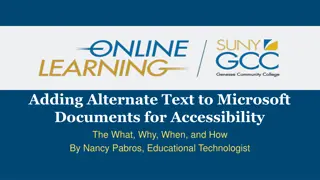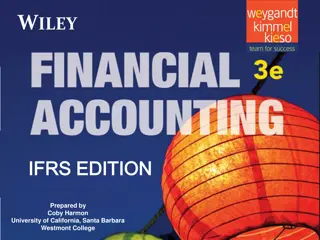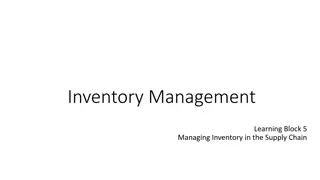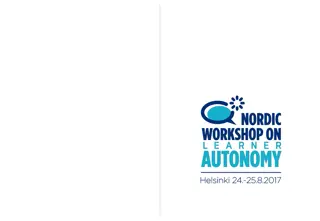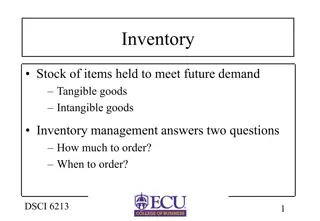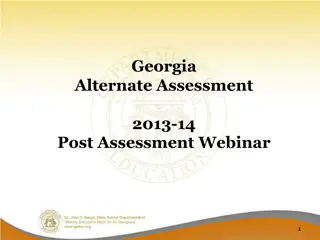Understanding Learner Characteristics Inventory in Alternate Assessment
Learner Characteristics Inventory (LCI) is a tool used to assess and describe students with significant intellectual disabilities participating in alternate assessments. The LCI covers eleven indicators including communication, language use, motor skills, and more. It helps districts ensure proper assessment participation for eligible students and allows for comparison across districts. Students typically have varied language abilities, multiple disabilities, and demonstrate basic reading and math skills. The inventory is completed annually for each eligible student to support appropriate educational services.
- Learner Characteristics Inventory
- Alternate Assessment
- Intellectual Disabilities
- Communication
- Special Education
Download Presentation

Please find below an Image/Link to download the presentation.
The content on the website is provided AS IS for your information and personal use only. It may not be sold, licensed, or shared on other websites without obtaining consent from the author. Download presentation by click this link. If you encounter any issues during the download, it is possible that the publisher has removed the file from their server.
E N D
Presentation Transcript
THE LEARNER CHARACTERISTICS INVENTORY Stephanie Thompson Alternate Assessment Specialist 2019-2020 School Year @EducateIN
AGENDA Purpose and Use of the Learner Characteristics Inventory (LCI) Overview of the LCI The Eleven Learner Characteristics A Summary of Students with the Most Significant Intellectual Disabilities Analyzing LCI Data Additional Resources @EducateIN 2
PURPOSE AND USE OF LEARNER CHARACTERISTICS INVENTORY The LCI is used to describe the population of students who take an alternate assessment based on the alternate achievement standards (Content Connectors). The LCI will be completed and analyzed at the local level to assist districts in ensuring only the students with the most significant intellectual disabilities are participating in the alternate assessment. LCI data can be used by districts in comparing similarities and differences in their students taking the alternate assessment with those students in other districts in the state taking the same assessment. 3 @EducateIN
OVERVIEW OF THE LCI The LCI includes eleven indicators ranging from communication and language use to current descriptions of reading and mathematics. The LCI will be completed annually as the student is found eligible to participate in the alternate assessment. When completing the LCI, educators should select the response that BEST describes the student and/or services the student is receiving for each indicator. @EducateIN 4
ELEVEN LEARNER CHARACTERISTICS 1. Primary Classroom Setting 2. Use of Assistive Technology 3. Expressive Communication 4. Receptive Language 5. Motor 6. Hearing 7. Vision 8. Engagement 9. Mathematics 10.Reading 11.Writing 5 @EducateIN
A SUMMARY OF STUDENTS WITH THE MOST SIGNIFICANT INTELLECTUAL DISABILITIES Students have varied levels of expressive/receptive language use. Most students use symbolic language and oral speech. Most students are able to follow 1-2 step directions presented through words with or without additional cues. Students are more likely to have multiple or complex disabilities including: Motor disabilities Sensory disabilities (hearing, vision, deafblind) Health concerns Students can typically read basic sight words and solve simple mathematics problems with a calculator and appropriate accommodations and supports. @EducateIN 6
WHAT IS THE STUDENTS PRIMARY CLASSROOM SETTING? Regular school, general education class inclusive (student in general education classes, special education services are primarily delivered in the general education classes) - at least 80% of the school day is spent in general education classes Regular school, resource room/general education class, student receives resource room services, but in general education classes 40% or more of the school day Regular school, primarily self-contained special education classroom, some academic inclusion in general educational classes (reading, mathematics, science, in addition to specials), but in a general education class less than 40% of the school day Regular school, self-contained special education classroom, some non-academic inclusion (student goes to art, music, PE), but returns to special education class for most of the school day Special school or homebound @EducateIN 7
WILL THE STUDENT USE ANY ASSISTIVE TECHNOLOGY DEVICES ON THE ASSESSMENT? No assistive technology devices will be used Alternate computer input/access devices (e.g., keyboards including alternate layout, mouse, joystick, touch screen) Alternate pointing system Symbols of all types (e.g., objects, tactile, raised line drawings, photos) Eye gaze board Magnification devices Switches Other @EducateIN 8
EXPRESSIVE COMMUNICATION Uses symbolic language to communicate (e.g., verbal or written words, signs, braille, or language-based augmentative systems) Uses intentional communication, but not at a symbolic language level to clearly express a variety of intentions (e.g., gestures, pictures, etc.) Communicates primarily through cries, facial expressions, change in muscle tone, etc., but no clear use of objects/textures, regularized gestures, pictures, signs, etc., to communicate @EducateIN
RECEPTIVE LANGUAGE Independently follows 1-2 step directions presented through words (e.g., words may be spoken, signed, printed, or any combination) and does NOT need additional cues Requires additional cues (e.g., gestures, pictures, objects, or demonstrations/models) to follow 1-2 step directions Alerts to sensory input from another person (e.g., auditory, visual, touch, movement), BUT requires actual physical assistance to follow simple directions Uncertain response to sensory stimuli (e.g., sound/voice, sight/gesture, touch, movement, smell) @EducateIN
MOTOR No significant motor dysfunction that requires adaptations Requires adaptations to support motor functioning (e.g., walker, adapted utensils, and/or keyboard) Uses wheelchair, positioning equipment, and/or assistive devices for most activities Needs personal assistance for most/all motor activities @EducateIN
HEARING Hearing within normal limits Corrected hearing loss within normal limits Hearing loss aided, but still with significant loss Profound loss, even with aids Unable to determine functional use of hearing @EducateIN
VISION Vision within normal limits Corrected vision within normal limits Low vision (uses vision for some activities of daily living) No functional use of vision for activities of daily living, or unable to determine functional use of vision @EducateIN
ENGAGEMENT Initiates and sustains social interactions Responds with social interaction, but does not initiate or sustain social interactions Alerts to others Does not alert to others @EducateIN
MATHEMATICS Applies computational procedures to solve real- life word problems Completes computational procedures Counts by rote to 5 Counts with 1:1 correspondence to at least 10, and/or makes numbered sets of items No observable awareness of numbers @EducateIN
READING Reads fluently with critical understanding in print or braille (e.g., to differentiate fact/opinion, point of view, emotional response, etc.) Reads fluently with basic (literal) understanding from paragraphs/short passages with narrative/informational texts in print or braille Reads basic sight words, simple sentences, directions, bullets, and/or lists in print or braille Aware of text/braille, follows directionality, makes letter distinctions, or tells a story from the pictures that is not linked to the text No observable awareness of print or braille @EducateIN
WRITING Conveys thoughts in complete sentences using correct spelling, grammar, and writing mechanics Writes words or sentences from a model or uses word cards or sentence strips to compose a complete sentence Uses pictorial representations to convey thoughts; writes alphabet letters on demand; writes name Locates print; understands that print has a purpose; recognizes name in print No observable awareness or use of print @EducateIN
AFTER COMPLETING THE LCI FOR A STUDENT Do the indicators selected for the student reinforce that the student has a significant intellectual disability? How do the student s characteristics compare to the summary of students with the most significant intellectual disabilities? How do the student s characteristics compare to those who participated in I AM in 2019? https://www.doe.in.gov/assessment/iam @EducateIN
ADDITIONAL RESOURCES For information about participation in the I AM assessment: Participation Guidance: https://www.doe.in.gov/sites/default/files/assessment/indiana-participation-guidance-updated- 091219.pdf Participation FAQ: https://www.doe.in.gov/sites/default/files/assessment/indiana-alternate-assessment-participation- guidance-faq-final-3-28-18.pdf Participation Flowchart: https://www.doe.in.gov/sites/default/files/assessment/indiana-alternate-assessment- participation-decision-flowchart-final-3-28-18.pdf For information about ESSA s 1% cap on alternate assessment participation: https://www.doe.in.gov/accountability/aa-essa-1capssa-1cap For additional I AM resources: https://www.doe.in.gov/assessment/iam https://iam.portal.airast.org/ @EducateIN
QUESTIONS? If you have questions about transitioning a student off the alternate assessment please contact Sarah Mohr at 317-232- 9153 or smohr@doe.in.gov. Stephanie Thompson 317-234-5601 sthompson2@doe.in.gov INassessments@doe.in.gov @EducateIN








